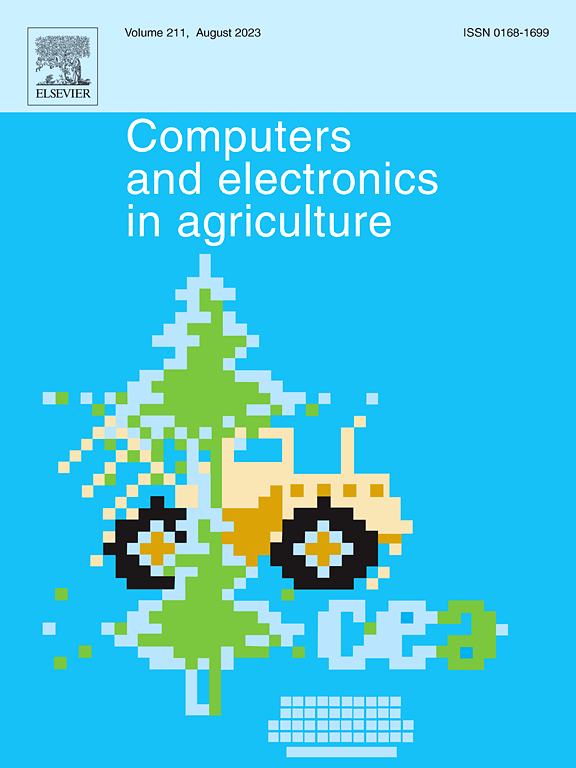SenNet: A dual-branch image semantic segmentation network for wheat senescence evaluation and high-yielding variety screening
IF 8.9
1区 农林科学
Q1 AGRICULTURE, MULTIDISCIPLINARY
引用次数: 0
Abstract
Wheat is one of the three primary staple crops globally, with the senescence of its leaves having a direct effect on yield. However, conventional senescence evaluation methods are mainly based on visual scoring, which are subjective, time-consuming, and hamper the investigation of mechanisms between senescence process and yield formation. High-throughput image-based plant phenotyping techniques offer a promising approach. However, extracting senescence-related semantic information from images presents challenges, including blurred edge segmentation, inadequate characterization of senescence features, and interference from complex field environments. Therefore, this study proposes a dual-branch image senescence segmentation model (SenNet), which integrates edge priors and local–global attention mechanisms, including local–global hierarchical attention mechanisms, gated convolution, and positional encoding modules. First, a wheat senescence dynamics image dataset (19530 images) was constructed, comprising 509 wheat varieties from a two-year and two-replicate field experiments. Then, the SenNet model achieved senescence image segmentation for various wheat varieties, enabling senescence dynamics analysis and high-yielding variety screening. The results showed that: 1) The mean Intersection over Union (mIoU) of the SenNet model was 95.41 %, which represented a 4.01 % improvement over the average mIoU of seven state-of-the-art models. 2) The contributions of the local–global hierarchical attention mechanism, gated convolution, and positional encoding module to the accuracy improvement of SenNet were 3.15 %, 1.62 %, and 1.03 %, respectively. 3) SenNet can be transferred across years and locations. The mIoU accuracy of the SenNet across locations is 96.01 %. Furthermore, the model trained in 2023 can be transferred to 2022 and 2024, achieving mIoU accuracies of 93.75 % and 93.27 %. 4) High-yielding varieties typically experience a later onset of senescence and faster senescence in later stages. Based on the senescence law, this study further constructed new dynamic traits of senescence (e.g., AreaUnderCurve). Leveraging the random forest-based yield prediction (R2 = 0.68) from the dynamic traits, high-yielding varieties were screened with an average precision, recall, F1 score, and accuracy of 81 %, 79 %, 80 %, and 87 %, respectively. This study provides an efficient method for monitoring senescence dynamics and predicting yield, offering new insights into the screening of high-yielding varieties.
SenNet:用于小麦衰老评价和高产品种筛选的双分支图像语义分割网络
小麦是全球三大主要粮食作物之一,其叶片衰老对产量有直接影响。然而,传统的衰老评价方法主要基于视觉评分,主观、耗时,不利于研究衰老过程与产量形成之间的机制。基于高通量图像的植物表型技术提供了一种很有前途的方法。然而,从图像中提取与衰老相关的语义信息存在挑战,包括模糊的边缘分割,衰老特征的不充分表征以及复杂现场环境的干扰。因此,本研究提出了一种双分支图像衰老分割模型(SenNet),该模型集成了边缘先验和局部-全局注意机制,包括局部-全局分层注意机制、门控卷积和位置编码模块。首先,构建了小麦衰老动力学图像数据集(19530幅),该数据集包含509个小麦品种的2年2重复田间试验数据。然后,利用SenNet模型对不同小麦品种进行衰老图像分割,进行衰老动态分析和高产品种筛选。结果表明:1)SenNet模型的平均mIoU为95.41%,比7个最先进模型的平均mIoU提高了4.01%;2)局部-全局分层注意机制、门控卷积和位置编码模块对SenNet准确率的贡献分别为3.15%、1.62%和1.03%。3) SenNet可以跨年、跨地点转移。SenNet跨位置的mIoU精度为96.01%。此外,2023年训练的模型可以转移到2022年和2024年,mIoU准确率分别达到93.75%和93.27%。4)高产品种衰老开始较晚,后期衰老速度较快。在衰老规律的基础上,本研究进一步构建了新的衰老动态特征(如AreaUnderCurve)。利用基于随机森林的动态性状产量预测(R2 = 0.68),筛选高产品种的平均精密度、召回率、F1评分和准确率分别为81%、79%、80%和87%。该研究提供了一种有效的衰老动态监测和产量预测方法,为高产品种的筛选提供了新的见解。
本文章由计算机程序翻译,如有差异,请以英文原文为准。
求助全文
约1分钟内获得全文
求助全文
来源期刊

Computers and Electronics in Agriculture
工程技术-计算机:跨学科应用
CiteScore
15.30
自引率
14.50%
发文量
800
审稿时长
62 days
期刊介绍:
Computers and Electronics in Agriculture provides international coverage of advancements in computer hardware, software, electronic instrumentation, and control systems applied to agricultural challenges. Encompassing agronomy, horticulture, forestry, aquaculture, and animal farming, the journal publishes original papers, reviews, and applications notes. It explores the use of computers and electronics in plant or animal agricultural production, covering topics like agricultural soils, water, pests, controlled environments, and waste. The scope extends to on-farm post-harvest operations and relevant technologies, including artificial intelligence, sensors, machine vision, robotics, networking, and simulation modeling. Its companion journal, Smart Agricultural Technology, continues the focus on smart applications in production agriculture.
 求助内容:
求助内容: 应助结果提醒方式:
应助结果提醒方式:


